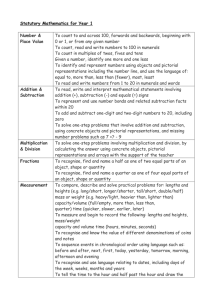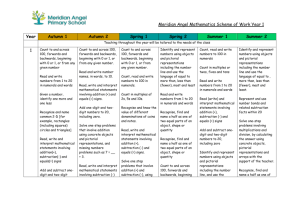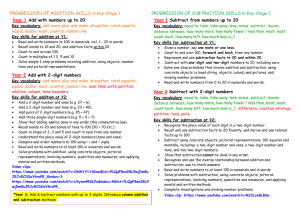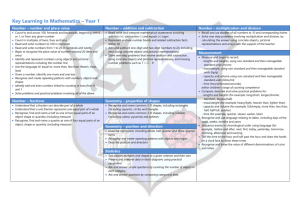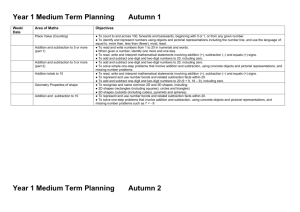Year 1 `Curriculum for Depth` programme of study `Term per page
advertisement
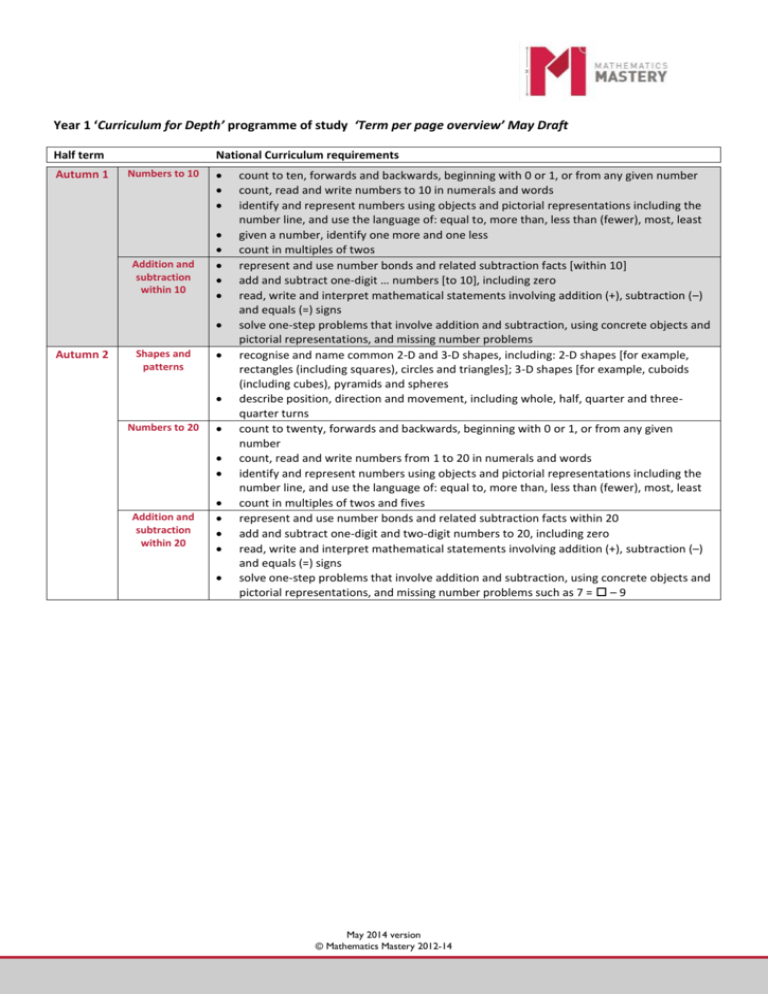
Year 1 ‘Curriculum for Depth’ programme of study ‘Term per page overview’ May Draft Half term Autumn 1 National Curriculum requirements Numbers to 10 Addition and subtraction within 10 Autumn 2 Shapes and patterns Numbers to 20 Addition and subtraction within 20 count to ten, forwards and backwards, beginning with 0 or 1, or from any given number count, read and write numbers to 10 in numerals and words identify and represent numbers using objects and pictorial representations including the number line, and use the language of: equal to, more than, less than (fewer), most, least given a number, identify one more and one less count in multiples of twos represent and use number bonds and related subtraction facts [within 10] add and subtract one-digit … numbers [to 10], including zero read, write and interpret mathematical statements involving addition (+), subtraction (–) and equals (=) signs solve one-step problems that involve addition and subtraction, using concrete objects and pictorial representations, and missing number problems recognise and name common 2-D and 3-D shapes, including: 2-D shapes [for example, rectangles (including squares), circles and triangles]; 3-D shapes [for example, cuboids (including cubes), pyramids and spheres describe position, direction and movement, including whole, half, quarter and threequarter turns count to twenty, forwards and backwards, beginning with 0 or 1, or from any given number count, read and write numbers from 1 to 20 in numerals and words identify and represent numbers using objects and pictorial representations including the number line, and use the language of: equal to, more than, less than (fewer), most, least count in multiples of twos and fives represent and use number bonds and related subtraction facts within 20 add and subtract one-digit and two-digit numbers to 20, including zero read, write and interpret mathematical statements involving addition (+), subtraction (–) and equals (=) signs solve one-step problems that involve addition and subtraction, using concrete objects and pictorial representations, and missing number problems such as 7 = – 9 May 2014 version © Mathematics Mastery 2012-14 Spring 1 Exploring calculation strategies within 20 Time Numbers to 40 Spring 2 Adding and subtracting within 40 Length, weight and volume represent and use number bonds and related subtraction facts within 20 add and subtract one-digit and two-digit numbers to 20, including zero read, write and interpret mathematical statements involving addition (+), subtraction (–) and equals (=) signs solve one-step problems that involve addition and subtraction, using concrete objects and pictorial representations, and missing number problems such as 7 = – 9 tell the time to the hour and half past the hour and draw the hands on a clock face to show these times recognise and use language relating to dates, including days of the week, weeks, months and years compare, describe and solve practical problems for time [for example, quicker, slower, earlier, later] and measure and begin to record time (hours, minutes, seconds sequence events in chronological order using language [for example, before and after, next, first, today, yesterday, tomorrow, morning, afternoon and evening] count to forty, forwards and backwards, beginning with 0 or 1, or from any given number count, read and write numbers from 1 to 20 in numerals and words identify and represent numbers using objects and pictorial representations including the number line, and use the language of: equal to, more than, less than (fewer), most, least given a number, identify one more and one less recognise the place value of each digit in a two-digit number (tens, ones) (Y2) represent and use number bonds and related subtraction facts within 20 add and subtract one-digit and two-digit numbers to 20, including zero add and subtract numbers using concrete objects, pictorial representations, and mentally, including: a two-digit number and ones; a two-digit number and tens; two two-digit numbers; adding three one-digit numbers (Y2) read, write and interpret mathematical statements involving addition (+), subtraction (–) and equals (=) signs solve one-step problems that involve addition and subtraction, using concrete objects and pictorial representations, and missing number problems such as 7 = – 9 compare, describe and solve practical problems for: lengths and heights [for example, long/short, longer/shorter, tall/short, double/half]; mass/weight [for example, heavy/light, heavier than, lighter than]; capacity and volume [for example, full/empty, more than, less than, half, half full, quarter] measure and begin to record the following: lengths and heights; mass/weight; capacity and volume May 2014 version © Mathematics Mastery 2012-14 Summer 1 Numbers to 100 Adding and subtracting within 100 Summer 2 Money Multiplication and division count to and across 100, forwards and backwards, beginning with 0 or 1, or from any given number count, read and write numbers from 1 to 20 in numerals and words identify and represent numbers using objects and pictorial representations including the number line, and use the language of: equal to, more than, less than (fewer), most, least recognise the place value of each digit in a two-digit number (tens, ones) (Y2) identify, represent and estimate numbers to 100 using different representations (Y2) given a number, identify one more and one less read and write numbers to at least 100 in numerals and in words represent and use number bonds and related subtraction facts within 20 add and subtract one-digit and two-digit numbers to 20, including zero add and subtract numbers using concrete objects, pictorial representations, and mentally, including: a two-digit number and ones; a two-digit number and tens; two two-digit numbers; adding three one-digit numbers (Y2) read, write and interpret mathematical statements involving addition (+), subtraction (–) and equals (=) signs solve one-step problems that involve addition and subtraction, using concrete objects and pictorial representations, and missing number problems such as 7 = – 9 recognise and know the value of different denominations of coins and notes solve one-step problems that involve addition and subtraction, using concrete objects and pictorial representations, and missing number problems such as 7 = – 9 solve one-step problems involving multiplication and division, by calculating the answer using concrete objects, pictorial representations and arrays with the support of the teacher recognise, find and name a half as one of two equal parts of an object, shape or quantity recognise, find and name a quarter as one of four equal parts of an object, shape or quantity May 2014 version © Mathematics Mastery 2012-14
